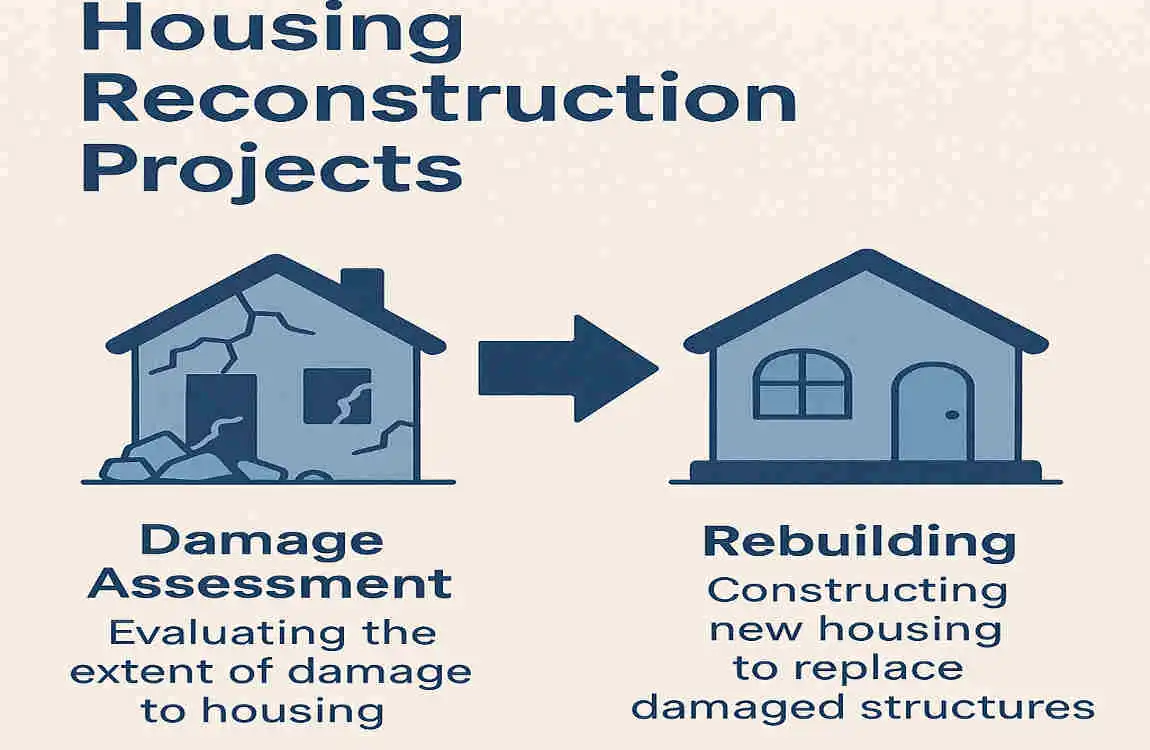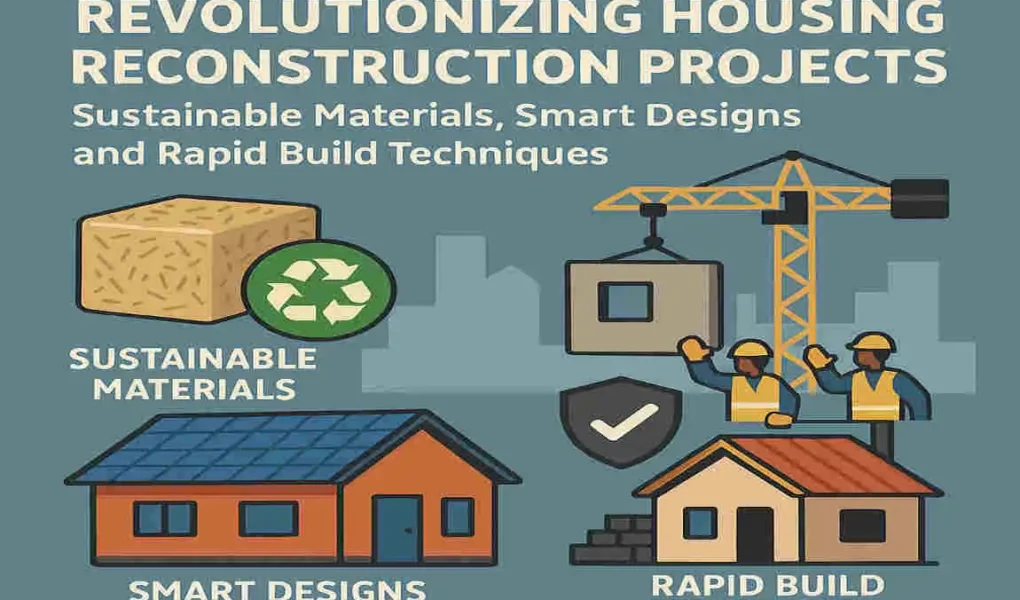When disaster strikes or when old buildings need a fresh start, housing reconstruction projects become essential. These projects are not just about rebuilding; they’re about creating homes that are better, stronger, and more sustainable. But traditional reconstruction methods often come with challenges such as long construction times, high costs, and significant environmental impacts.
That’s where new industry trends come in. Sustainable materials, innovative designs, and rapid building techniques are changing the game. They’re making it possible to rebuild quickly, efficiently, and in a way that’s kinder to our planet.
Understanding Housing Reconstruction Projects

Before we dive into the exciting innovations, let’s make sure we’re all on the same page about what a housing reconstruction project actually is.
At its core, a housing reconstruction project is about rebuilding or renovating residential structures. This could be in response to a natural disaster that destroyed homes, or part of a larger effort to update aging infrastructure or revitalize an urban area.
These projects typically involve several key stages, from planning and design to construction and finishing touches. And throughout the process, there are many components to consider, from the materials used to the layout of the space.
But here’s the thing: the world is changing, and so are our needs and expectations. We’re more aware than ever of the impact our buildings have on the environment, and we’re looking for ways to make our homes more sustainable and efficient.
That’s where innovation comes in. By embracing new materials, designs, and techniques, we can meet these modern demands and create housing that’s not just functional, but also forward-thinking.
Sustainable Materials Transforming Reconstruction
One of the most exciting areas of innovation in housing reconstruction is the use of sustainable materials. But what exactly makes a material sustainable?
In a nutshell, sustainable materials are renewable, recyclable, and have a low environmental impact. They’re designed to minimize environmental impact while still providing the strength and durability we need in our homes.
Let’s take a closer look at some of the most promising sustainable materials being used in housing reconstruction today:
Bamboo and Engineered Wood Products
Bamboo is a superstar in the world of sustainable building materials. It grows quickly, requires little water, and is incredibly strong. When used in construction, bamboo can be a great alternative to traditional wood.
Engineered wood products, like cross-laminated timber, are another exciting option. Gluing layers of wood together creates a strong, durable material that can be used for everything from walls to flooring.
Recycled Steel and Concrete
Recycling is a key part of sustainability, and it’s making its way into construction. Recycled steel and concrete can be used to create strong, long-lasting structures while reducing waste and the demand for new materials.
Hempcrete and Other Bio-Composites
Hempcrete is a unique material made from hemp fibers and a lime-based binder. It’s lightweight, breathable, and highly insulating. Plus, it’s completely biodegradable, making it an excellent choice for eco-friendly construction.
Other bio-composites, such as those made from agricultural waste or algae, are also showing promise in sustainable building.
Reclaimed Timber and Bricks
Finally, don’t forget about the power of reuse. Reclaimed timber and bricks can give new life to old materials, reducing waste and adding character to reconstructed homes.
Using sustainable materials in housing reconstruction comes with a host of benefits. For one, these materials are often more durable than their traditional counterparts, meaning they’ll last longer and require less maintenance over time.
They also have a lower carbon footprint, which is excellent news for the planet. And while upfront costs may be higher in some cases, the long-term savings can be significant thanks to improved energy efficiency and reduced repair needs.
But don’t just take our word for it. There are plenty of real-world examples of housing reconstruction projects that have successfully used sustainable materials. From bamboo homes in earthquake-prone regions to hempcrete houses in eco-conscious communities, these projects are showing what’s possible when we prioritize sustainability.
If you’re thinking about using sustainable materials in your own housing reconstruction project, here are a few tips to keep in mind:
- Do your research and choose materials that align with your project’s goals and budget.
- Work with experienced professionals who understand sustainable building practices.
- Consider the long-term benefits, not just the upfront costs, when making your decisions.
- Look for certifications and standards to guide your material choices.
Smart Designs for Modern Housing Reconstruction
Sustainable materials are just one piece of the puzzle in revolutionizing housing reconstruction. Intelligent design is another key factor, helping create homes that are not only eco-friendly but also more livable and efficient.
So what exactly do we mean by “smart design”? In the context of housing reconstruction, clever design refers to features and layouts that prioritize energy efficiency, adaptability, and occupant well-being.
Let’s break down some of the key elements of intelligent design in reconstruction projects:
Passive Solar Design and Natural Ventilation
One of the most critical aspects of intelligent design is making the most of natural resources. Passive solar design involves orienting and designing a home to take advantage of the sun’s heat and light, reducing the need for artificial heating and cooling.
Natural ventilation is another key feature, allowing fresh air to circulate through the home and reducing reliance on energy-intensive HVAC systems.
Modular and Flexible Floor Plans
Gone are the days of rigid, one-size-fits-all floor plans. In smart-designed homes, modularity and flexibility are key. This means creating spaces that can be easily adapted to changing needs, whether that’s a growing family or a shift to remote work.
Modular construction techniques can also speed up the reconstruction process, enabling quicker, more efficient construction.
Integration of Green Roofs and Vertical Gardens
Green roofs and vertical gardens are becoming increasingly popular in smart-designed homes. These features not only add a touch of nature to urban environments but also help with insulation, air purification, and even food production.
Incorporation of IoT Devices and Home Automation
Finally, bright designs often incorporate Internet of Things (IoT) devices and home automation systems. These technologies can help monitor and manage energy usage, control lighting and temperature, and even detect potential issues before they become significant problems.
By incorporating these innovative design elements, housing reconstruction projects can create homes that are not only more sustainable but also more comfortable and efficient in the long run. And the benefits don’t stop there— bright designs can also help reduce operational costs and extend the home’s longevity.
There are countless examples of smartly designed housing reconstruction projects making a difference around the world. From net-zero energy homes in cold climates to adaptable modular houses in disaster-prone areas, these projects are showing what’s possible when we prioritize innovative design.
Rapid Build Techniques Revolutionizing Housing Reconstruction

Speed is of the essence in housing reconstruction, especially in the aftermath of a disaster. That’s where rapid-build techniques come in, revolutionizing how we approach these projects.
Rapid build, or accelerated construction, techniques aim to build faster, more efficiently, and with less waste. Let’s take a look at some of the most promising techniques being used today:
Prefabrication and Modular Construction
Prefabrication involves building home components off-site in a controlled factory setting. These components can then be transported to the construction site and assembled quickly and efficiently.
Modular construction takes this concept a step further, allowing entire sections of a home to be built off-site and combined on-site. This can significantly reduce construction time and minimize disruption to the surrounding area.
3D Printing of Building Components
3D printing technology is making waves in the construction industry, allowing for the rapid production of complex building components. From walls and floors to decorative elements, 3D printing can accelerate reconstruction while maintaining high precision and quality.
Use of Drones and Robotics in Construction
Drones and robotics are also playing a role in rapid build techniques. Drones can be used for site surveying, monitoring progress, and even delivering materials to hard-to-reach areas.
Robotics, on the other hand, can help automate repetitive or dangerous tasks, increasing efficiency and reducing the risk of injury on the job site.
Advanced Project Management Tools
Finally, advanced project management tools are helping to streamline the reconstruction process. From real-time collaboration platforms to sophisticated scheduling and resource management software, these tools can help keep projects on track and minimize downtime.
The advantages of rapid build techniques are apparent. They allow for faster construction times, which is crucial in the aftermath of a disaster. They also enable better quality control and waste reduction, as components are often built in controlled factory settings.
And let’s not forget about the cost savings. By building more efficiently and with less waste, rapid build techniques can help keep costs down and make housing reconstruction more affordable.
But the real magic happens when we combine rapid build techniques with sustainable materials and innovative designs. This trifecta of innovation can lead to housing reconstruction projects that are not only quick and cost-effective but also eco-friendly and livable.
There are plenty of inspiring examples of rapid build success in housing reconstruction. From 3D-printed homes for disaster survivors to modular communities built in record time, these projects are showing what’s possible when we embrace rapid build techniques.
Challenges and Solutions in Implementing Innovative Reconstruction Practices
While the benefits of sustainable materials, innovative design, and rapid construction techniques are clear, challenges remain when implementing these practices in housing reconstruction.
One of the biggest hurdles is the upfront cost. Sustainable materials and advanced technologies can sometimes come with a higher price tag, which can be a barrier for some projects.
Technical expertise is another challenge. Not all construction teams have experience with the latest materials and techniques, which can slow down the adoption of these innovations.
Regulatory approvals can also be a roadblock. In some areas, building codes and regulations may not yet keep pace with the latest advancements in sustainable, rapid construction.
But don’t worry—there are solutions to these challenges. Government incentives and subsidies can help offset the upfront costs of using sustainable materials and technologies.
Partnerships between construction companies, material suppliers, and research institutions help build the necessary expertise and knowledge base.
Training programs and certifications can also help upskill the workforce and ensure that best practices are followed.
And as for regulatory approvals, there’s good news on the horizon. Emerging standards and certifications are being developed to support sustainable, innovative, and rapid construction methods. These can help guide projects and ensure that they meet the requirements.
The most critical factor in successful reconstruction is community engagement and stakeholder collaboration. By involving the people who will live in these homes, as well as local authorities and other key players, we can create projects that truly meet the community’s needs.
Future Outlook: The Next Generation of Housing Reconstruction Projects
As exciting as the current innovations in housing reconstruction are, the future looks even brighter. Several trends are shaping the next generation of reconstruction projects, promising to elevate sustainability, efficiency, and livability.
One of the most exciting trends is the use of AI-driven design. By harnessing the power of artificial intelligence, architects and designers can create homes that are optimized for energy efficiency, comfort, and adaptability.
The circular economy is another key trend to watch. In a circular economy, materials are kept in use for as long as possible, and waste is minimized. This approach could revolutionize the way we think about building materials and construction waste in housing reconstruction.
Fully automated construction sites are also on the horizon. By combining robotics, drones, and advanced project management tools, we could see entire homes built with minimal human intervention, further speeding up the reconstruction process.
These trends have the potential to affect affordability, disaster resilience, and urban development significantly. By making housing reconstruction faster, more efficient, and more sustainable, we can help more people access safe, comfortable homes.
But to take advantage of these advances, businesses and developers need to start preparing now. That means investing in research and development, building partnerships with innovative suppliers and technology companies, and staying up to date with the latest trends and standards.
By embracing these next-generation innovations, the housing reconstruction industry can lead the way towards a more sustainable, resilient, and equitable future.




